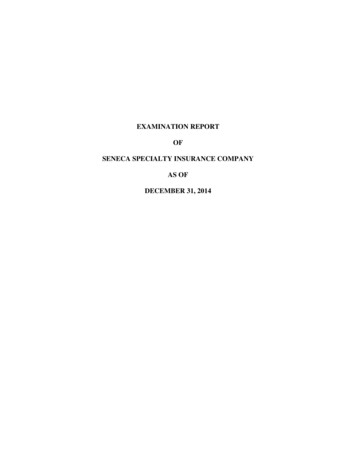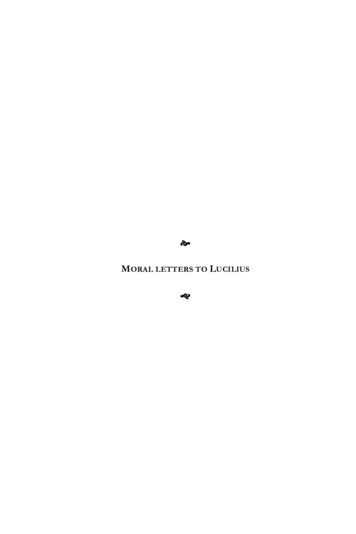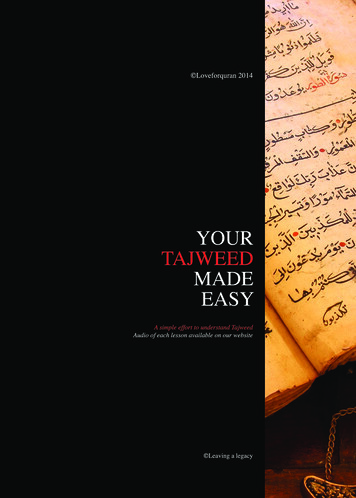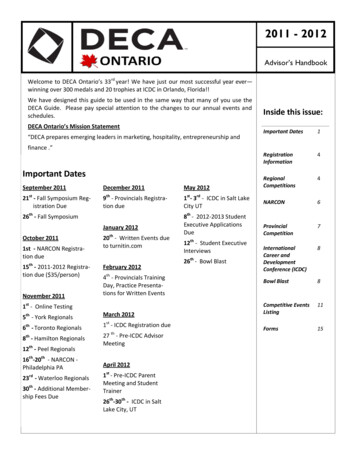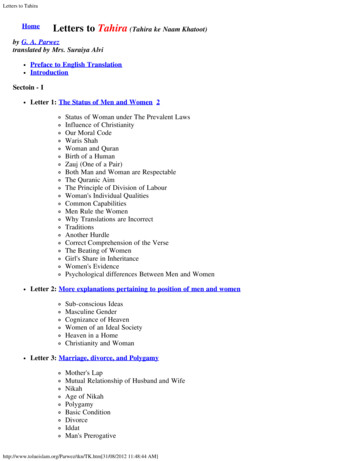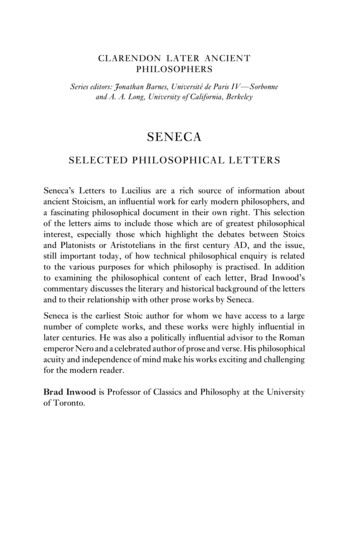
Transcription
CLARENDON LATER ANCIENTPHILOSOPHERSSeries editors: Jonathan Barnes, Université de Paris IV—Sorbonneand A. A. Long, University of California, BerkeleySENECASELECTED PHILOSOPHICAL LETTERSSeneca’s Letters to Lucilius are a rich source of information aboutancient Stoicism, an influential work for early modern philosophers, anda fascinating philosophical document in their own right. This selectionof the letters aims to include those which are of greatest philosophicalinterest, especially those which highlight the debates between Stoicsand Platonists or Aristotelians in the first century AD, and the issue,still important today, of how technical philosophical enquiry is relatedto the various purposes for which philosophy is practised. In additionto examining the philosophical content of each letter, Brad Inwood’scommentary discusses the literary and historical background of the lettersand to their relationship with other prose works by Seneca.Seneca is the earliest Stoic author for whom we have access to a largenumber of complete works, and these works were highly influential inlater centuries. He was also a politically influential advisor to the Romanemperor Nero and a celebrated author of prose and verse. His philosophicalacuity and independence of mind make his works exciting and challengingfor the modern reader.Brad Inwood is Professor of Classics and Philosophy at the Universityof Toronto.
PUBLISHED IN THE SERIESAlcinous: The Handbook of PlatonismJohn DillonEpictetus: Discourses, Book Robert DobbinGalen: On the Therapeutic Method, Books I and IIR. J. HankinsonPorphyry: IntroductionJonathan BarnesSeneca: Selected Philosophical LettersBrad InwoodSextus Empiricus: Against the EthicistsRichard BettSextus Empiricus: Against the GrammariansDavid Blank
SENECASELECTED PHILOSOPHICAL LETTERSTranslated with anIntroduction and Commentary byBRAD INWOOD1
1Great Clarendon Street, Oxford Oxford University Press is a department of the University of Oxford.It furthers the University’s objective of excellence in research, scholarship,and education by publishing worldwide inOxford New YorkAuckland Cape Town Dar es Salaam Hong Kong KarachiKuala Lumpur Madrid Melbourne Mexico City NairobiNew Delhi Shanghai Taipei TorontoWith offices inArgentina Austria Brazil Chile Czech Republic France GreeceGuatemala Hungary Italy Japan Poland Portugal SingaporeSouth Korea Switzerland Thailand Turkey Ukraine VietnamOxford is a registered trade mark of Oxford University Pressin the UK and in certain other countriesPublished in the United Statesby Oxford University Press Inc., New York Brad Inwood The moral rights of the author have been assertedDatabase right Oxford University Press (maker)First published First published in paperback All rights reserved. No part of this publication may be reproduced,stored in a retrieval system, or transmitted, in any form or by any means,without the prior permission in writing of Oxford University Press,or as expressly permitted by law, or under terms agreed with the appropriatereprographics rights organization. Enquiries concerning reproductionoutside the scope of the above should be sent to the Rights Department,Oxford University Press, at the address aboveYou must not circulate this book in any other binding or coverand you must impose the same condition on any acquirerBritish Library Cataloguing in Publication DataData availableLibrary of Congress Cataloging in Publication DataData availableTypeset by Laserwords Private Limited, Chennai, IndiaPrinted in Great Britainon acid-free paper byCPI Antony Rowe, Chippenham, WiltshireISBN – – – – (hbk) – – – – (pbk)
For my parents
P R E FAC EIn the course of my work on this book I have incurred more debts than I canfully recall, let alone acknowledge here. It is a genuine pleasure to thank,first and foremost, the Centre for Advanced Study in the BehaviouralSciences for their support during a sabbatical leave in – . Withoutthe respite and stimulus provided by that unique institution this bookwould never have been completed. I am also very grateful to the CanadaResearch Chair program of the Canadian government and to my friendsand colleagues at the University of Toronto for invaluable and unstintingsupport. I owe a great deal to the generous and careful work of my researchassistants in the Department of Classics, Vicki Ciocani and Emily Fletcher.My initial work on Seneca’s letters was encouraged by an invitation fromthe ancient philosophy group at Cambridge University to a workshop onSeneca’s letters in May . The discussion at that workshop contributeda great deal to several of the commentaries in this book. Later, studentsin two of my graduate seminars (in and ) at the Universityof Toronto served as willing guinea pigs and ingenious collaborators. Akeen group of graduate students at New York University provided helpfulfeedback on several letters during a series of visits in ; I am gratefulto Phillip Mitsis for the invitation to NYU and for his encouragement andadvice on Seneca over many years. Tony Long has been both supportiveof and patient about this project for a very long time. His acute commentsand those of his fellow series editor Jonathan Barnes have improved thecommentary and translation at many points; no doubt I should have takentheir advice more consistently. David Sedley’s work on the relationshipbetween Stoic physics and ethics in Seneca’s work (especially in hisarticle ‘Stoic Metaphysics at Rome’, Sedley ) has been a valuablesource of stimulus. The need to respond to John Cooper’s challengingdiscussion ‘Moral Theory and Moral Improvement: Seneca’ (Cooper ) provoked many fruitful lines of enquiry. The ancient philosophygroup at the University of Chicago has done a great deal for the studyof Seneca during the time when this book was under construction (notleast by organizing a key conference in April ) and their confidence inthe value of Senecan studies in a contemporary philosophical setting hasfostered a great deal of work by many people from which I have been ableto benefit.
viii Some commentaries have benefitted from work on papers originallywritten for oral presentation and since published separately. The commentary on Letter is intimately connected to a paper given at theUniversities of Buffalo, British Columbia, and Alberta, ‘Reason, Rationalization and Happiness’; it now appears as chapter of Reading Seneca(Inwood ). The commentary on Letter began as a sketch for‘Getting to Goodness’, delivered to the Princeton Ancient PhilosophyColloquium and at the University of Pittsburgh and now published aschapter of Reading Seneca. The commentary on Letter has beenenriched by discussion of an unpublished paper presented at CornellUniversity, the University of Arizona, and UC Santa Barbara.I owe a particularly concrete debt of gratitude to Margaret Graver, whosubjected the penultimate draft of my translation to an exacting scrutiny.Her influence has saved me from many errors and infelicities and I haveoften accepted her suggestions for better wording; the remaining blundersare my own fault. Margaret also read an early version of the commentarieswith a critical eye; her comments and suggestions have improved mycomment on almost every letter.It is no mere cliché to say that without the encouragement, advice, andloving support of my wife, Niko Scharer, I would not have been able towrite this book. An even older debt is owed to my parents, Marg and BillInwood. For many decades they have provided a wonderful education,both moral and intellectual. My brothers and I had the privilege of growingup in a household where critical enquiry, teaching, intellectual challenge,and a passion for fairness were in the fabric of daily life. It has taken mea long time to see how precious a gift our parents gave us. Humbly, Idedicate this book to them.
CONTENTSIntroductionAbbreviations and ConventionsxixxvTRANSLATIONS1Letter Letter Letter Letter Letter Letter Letter Letter Letter Letter Letter Letter Letter Letter Letter Letter Letter COMMENTA RYGroup (Letters , , )Letter Letter Letter 105
xGroup (Letters and )Letter Letter Group (Letters and )Letter Letter Group (Letters , and )Letter Letter Letter Group (Letters – )Letter Letter Letter Letter Letter Letter Letter BibliographyIndex LocorumGeneral Index
I N T RO D U C T I O NSeneca’s Life and WorksLucius Annaeus Seneca, better known as Seneca the Younger, was acomplex figure. At some point between and at Corduba inRoman Spain, he was born into a prosperous and prominent provincial Roman family. His father, Seneca the Elder, was an importantliterary figure in Rome itself, famous as the author of the Controversiae and Suasoriae, compilations of rhetorical declamations by the mostfamous speakers of the day. Seneca the Younger was the middle ofthree sons; while his older brother had a successful if conventional political career leading to a provincial governorship, the youngestson lived a private life and did not achieve senatorial rank. Senecathe Younger took an early interest in philosophy, oratory, and literature and over the course of a long career rose to become a senior adviser to the emperor Nero and the most prominent literaryfigure of his generation, publishing extensively in both prose andverse.Seneca’s early life is difficult to document, although his career becomeseasier to track after he was forced into exile in owing to some sortof court intrigue.¹ He was recalled to Rome and political influence in . For readers of this volume, the most important facts are his earlyinterest in philosophy, his lifelong commitment to philosophical study andwriting, and his determination to combine those interests with a long andactive political career as well as a major role as a prominent literary figure.He was the author of many tragedies (whose relationship to philosophyis a controversial issue) and a famous orator; his satirical work on theemperor Claudius, the Apocolocyntosis, is yet another demonstration of hisvirtuosity.Seneca’s influence at Nero’s court lasted for more than a decade, butwaned as the character of the emperor and his regime deteriorated. Havingwithdrawn from public life in the period between and , Senecawas eventually forced into committing suicide in the spring of because¹ The best account of Seneca’s life and background is still Griffin : part I. See alsoInwood : ch. .
xii of the emperor’s suspicion that Seneca was involved with a conspiracyagainst him.The chronology of many of Seneca’s works is debatable, althoughGriffin , Appendix A is a reliable guide. The Letters, however, aresecurely datable to the period after when Seneca, then in his midsixties and at the end of a long career, was in retirement. This settingfor the composition of the Letters is often relevant to their tone andthemes.The Nature of Seneca’s letters²It is now widely agreed that Seneca’s letters in their present form, whatevertheir relationship might have been to a real correspondence, are creationsof the writer’s craft.³ Like the dialogues of Plato, Seneca’s letters create anatmosphere of interpersonal philosophical exchange, with the differencethat the medium of this exchange is not face-to-face conversation butintimate correspondence between friends.⁴ The contributions to thisconversation of Lucilius, a long-time friend of Seneca’s, must be inferredfrom what Seneca says to him, but as all readers of the letters haverecognized, the assumption of a dialogue between the two friends isan important factor shaping the way the letters are meant to work forreaders.⁵ For the most part the letters function as independent worksof philosophical literature and there is little reason to suppose thatreaders of them were expected to have read the rest of Seneca’s works,and almost certainly not his dramas. In commenting on them, though,a certain amount of comparison with his other philosophical works isdesirable.² More detailed discussion of the issues raised here is given in ‘The Importance of Formin the Letters of Seneca the Younger’ in Morrison and Morel, forthcoming. Recent studiesfrom which I have benefitted are Wilson , and , and Teichert .³ Note the promise of literary immortality to Lucilius at . (Letter , section ;for reference conventions in this book, see below pp. xxiii, xxv). See the discussion byGriffin , Appendix B . For a generous survey of earlier views see Mazzoli .More particularly, see Leeman , ; Abel ; Cancik : – ; and chapter ofMargaret Graver’s unpublished dissertation ( ), Therapeutic Reading and Seneca’s MoralEpistles.⁴ See Teichert : – .⁵ Teichert ( : – ) points out that the one-sidedness of the conversation betweenSeneca the letter-writer and his silent partner Lucilius encourages a greater engagement onthe part of the reader, who can play both the role of reader and of recipient of the letters,being addressed by the author in both modes. I am, however, sceptical about Teichert’ssupposition that the author’s philosophical experience is meant to be shaped by the natureof the correspondence. As author Seneca is surely more in control than that.
xiiiOther essential facts about the letters can be summarized quickly.⁶Despite appearances, our corpus of letters is significantly incomplete;originally there were more than the twenty books which now survive; anexcerpt from a letter on style is preserved by Aulus Gellius (Gel. . )from Book . Among other things, this excerpt confirms that literarythemes remained important in later books of the letters; the appearancein our twenty-book collection of an accelerating emphasis on ‘tough’philosophical themes might to some extent be misleading. Furthermore,the collection we do have circulated in at least two volumes in late antiquity(Letters – and – ). The fact that the collection came to circulatein separate components in antiquity is significant for understanding itsstructure. L. D. Reynolds⁷ once suggested that the incompleteness at theend of our collection might be the result of an early loss of one entirevolume of letters. But it is also possible that small groups of letters havebeen lost within the span of our transmitted collection, and the volume joinbetween and would be a particularly likely location for such a loss.⁸The letters are not alone in having been maimed; the Natural Questionsalso suffered severe damage early in the history of its transmission.⁹The incompleteness of our collection is significant when we consider theissue of the internal articulation of the letters, how they were meant to begrouped for reading or publication. The hermeneutical issues surroundingthis issue are perhaps insoluble, since we cannot any longer look at thewhole collection of letters as Seneca meant it to be read. Moreover, it has sofar proven difficult to separate philosophical interpretation from questionsof structure and literary form.¹⁰ If one’s ultimate goal is a philosophicalinterpretation of the letters, it will not help much to seek guidance from a⁶ Parts of what follows are adapted from ‘The Importance of Form in the Letters ofSeneca the Younger’ (Inwood forthcoming).⁷ Reynolds : .⁸ See Cancik : – , for sensible discussion of the internal completeness of ourcollection. In n. , p. , she notes that Reynolds fails to consider the possibility that lettersmay have been lost at the join between the two volumes of letters that came down separatelythrough the medieval manuscript tradition.⁹ In addition to the loss of two half books, the order of the books in our NQ seems tohave become seriously confused in the course of transmission. It is likely that the originalorder was , a, b, , , , , , and quite possible that the work was left incomplete onSeneca’s death. For further discussion and references, see my ‘God and Human Knowledgein Seneca’s Natural Questions’, ch. in Inwood .¹⁰ Virtually everyone who writes on Seneca’s letters has taken an at least implicit positionon their pedagogical or literary structure and a review of the issue would be both lengthyand inconclusive. But some works stand out for their relative good sense. See Maurach ; Cancik , who commits herself to the view that the organizational principle of thecollection is pedagogical rather than doctrinal, is unusually sensitive to the methodologicalproblems involved in discussing the plan and organization of the collection and emphasizes
xiv view about their literary form which is itself partly shaped by an incipientphilosophical interpretation.These are very serious challenges to the reader, and reflection on thesedifficulties makes the decision to select groups of letters for philosophicalcomment less unjustifiable than it might otherwise be; it certainly makesserious philosophical work on the letters a daunting prospect. But theLetters to Lucilius remain Seneca’s masterpiece, and this is in part becausethey are philosophical letters. We should, then, ask why he chose this form.Why, at the end of a long life, a long and tumultuous political career, and(perhaps most relevant) at the end of a brilliant literary career of unmatchedversatility, write letters? The answer is not immediately clear and Seneca’smotivation was probably not simple. In the commentary I assume that thechoice of the letter as the literary form is in fact relevant to what Senecaaimed to accomplish, and that his inspiration for writing philosophicalletters came from many sources, the most important of which was perhapsEpicurus’ published philosophical correspondence, which was originallymuch more extensive than and much of it different in character fromthe letters preserved in Diogenes Laertius, book .¹¹ At the same time,Seneca’s self-conception as an author of Latin literature is relevant. Notonly should we assume (what can also be confirmed by observation) thatCicero’s philosophical works, especially the De Finibus and the TusculanDisputations, were a stimulus for his work, but it is also likely that the thenrecent publication of Cicero’s Letters to Atticus contributed to the decisionto add the literary epistle to the other genres in which Seneca chose towrite.¹² (Seneca had, after all, been a brilliantly successful author in moregenres than any other Roman writer one can think of: he was a poet,dramatist, public speaker, and essayist in many styles.) The approach toSeneca taken in the present commentary presupposes that his character asthe complexity of the techniques used by Seneca (in her view) to give unity and texture tothe work.¹¹ By Seneca’s time there had been a long tradition of philosophical letter-writing. Therewere corpora of letters attributed to Plato, Aristotle, Pythagoreans, Cynics and others. Fora fuller discussion of Seneca’s place in this tradition and the influence of the tradition onthe way his letters are written, see ‘The Importance of Form in the Letters of Seneca theYounger’ (Inwood forthcoming).¹² See Griffin : – . For background see Maurach : – . The majorlimitation of his assessment of generic influence on Seneca’s letters is his nearly exclusiveconcentration on literary form and his emphasis on Seneca’s situation within his Latin literarytradition. Hence (pp. – ) he downplays the importance of Epicurus’ letters and focussesmore on Horace and Lucilius. Similarly, his grudging concession of possible Ciceronianinfluence on the project of the letters (p. ) seems to underestimate the motivational powerof authorial aemulatio.
xva man of letters is of great importance,¹³ although this in no way detractsfrom an appreciation of the philosophical intensity of Seneca’s project.Seneca’s Motivation as AuthorIt is common, in the interpretation of Seneca’s letters, to emphasize theapparent ‘moral progress’ of Lucilius throughout the collection. There isan increase in the philosophical intensity and difficulty of the letters asthe reader proceeds from the first letter to the more technical themes ofthe letters which come latest in our surviving collection. It is, further,common to emphasize the role Seneca apparently takes on, not just inthese letters, as a guide to and inspiration for the moral improvementof his addressee. Sometimes this role is described as that of a ‘spiritualguide’ and often this characterization of Seneca’s nature as an author hasa powerful influence on the interpretation of his letters. John Cooper, forinstance, has been inspired by Ilsetraut Hadot’s superb analysis of Senecain Seneca und die griechisch-römische Tradition der Seelenleitung (Hadot ) to treat him primarily as such a spiritual guide (Cooper ). Thisis a risky characterization of Seneca’s central motivation as an author, andsome critics have tended to treat Seneca’s self-presentation (as an adviserand correspondent) as though it were his fundamental philosophicalmotivation. It is tempting but unwarranted to assume that virtually all ofSeneca’s philosophical activity, his interest in theory and argumentation,his concern for understanding the phenomena of the natural and humanworld and for convincing his readers of what is the case about it, shouldbe approached on the assumption that he is first and foremost a spiritualguide, someone whose interests, activity, and methods dominate over themore theoretical aspects of philosophy.Yet one of the most persistent problems in understanding Seneca hasalways been the large number of roles he plays. In the corpus of his writingand in the relatively rich historical record we possess about him we seeSeneca in many guises: as an occasionally Machiavellian political figure ofgreat but transient power, as an eloquent orator devoted to the artfulnessof fine speech as much as to its power to persuade, as a dark but brilliantpoet, as a friend, son, and brother, as a philosopher of surprisingly wideinterests, and as a moral adviser. The contradictions often seen in Seneca’slife and works stem in part from this variety of roles, and it is obvious¹³ See the longer discussion in chapter of Inwood .
xvi that choosing one role or another as central has a considerable impacton how one understands Seneca. Perhaps the chief frustration faced instudying Seneca lies in the absence of confidence about which role, ifany, should be treated as central. It would be a great help if we had afully reliable biography or autobiography of the man, but despite ourmass of information about his life we do not.¹⁴ That is not to say that weknow nothing about the place of the letters in Seneca’s philosophical andauthorial career—far from it. Griffin’s dating of the letters to the periodafter his forced retirement in is secure; since Seneca was forced tocommit suicide in the letters can be dated fairly exactly. This meansthat we must bear in mind that Seneca is at the same period workingon the Natural Questions and quite possibly had only recently completedthe large and frequently quite technical work On Favours.¹⁵ In assessingSeneca’s basic motivations as author of the letters, we should not neglectthese facts; the range of works he wrote at this stage of his career ought tomake us hesitate before assuming that Seneca’s main intention was to be aspiritual guide for the reader. We should perhaps take a wider view of thequestion.In recent years two developments have occurred that bear on thequestion of how to approach Seneca’s character as a philosophical writer.Among students of ancient philosophy there has been a dramatic increaseof interest in and sympathy for the notion that moral guidance and moralimprovement are an important part of philosophy; many philosophers inthe English-speaking world generally have embraced the humanly practical, political, and psychological functions of philosophy in a way that couldnot have been predicted in or even . The other development hasbeen in the study of literature. Students of ancient literature are now muchmore wary of relatively simple biographical claims based on the worksthey study; there is a much greater appreciation now for the elusivenessof the author behind the texts he or she wrote, for the complexity ofthe roles one author may play, and for the difficulty of isolating withsufficient confidence a central and determinative biographical fact whichmight guide our understanding of literary works.These two developments pull the study of Seneca’s philosophical worksin opposite directions. Philosophers are now much more likely to take¹⁴ See Edwards : – ; this is true despite the magnificent work of Griffin .¹⁵ Griffin : appendix A; see especially n. G, p. . Here Griffin takes account ofSeneca’s lost work On Moral Philosophy, of which sparse fragments survive in Lactantius(collected in F. Haase’s – Teubner edition of Seneca’s works, vol. , – ). Thesefragments do not suggest that the work was of the character indicated by Seneca in hisallusions to it as a work in progress in . – , . , and . . See Leeman : – .
xviiSeneca’s role as a moral (or ‘spiritual’) guide to be philosophically relevant,to play a central role in the understanding of his philosophical works,especially of his letters. Indeed, in light of the impact of Pierre Hadot,Michel Foucault, and Martha Nussbaum we would hardly expect thetherapeutic capacities of philosophy to be of less interest than they werea generation ago. And students of literature are now much less likelyto embrace any biographical facts or presumed motivations as central tounderstanding Seneca’s works. In themselves, both of these developmentsare welcome; it is now much less likely that philosophers will pass Senecaby as having nothing of philosophical interest to say and students ofliterature are less likely to marginalize for the wrong sort of reasons thephilosophically robust parts of Seneca’s corpus.Nevertheless, in approaching Seneca’s letters philosophically, it issurely a mistake to take it for granted that the author’s central motivationis to play the role of moral or ‘spiritual’ guide for his readers. That isoften his persona, his authorial voice, to be sure. But it is as much amistake to take that authorial self-presentation as the key to philosophicalinterpretation as it would be to begin from his role as political adviseror tragic poet. The role of guide and adviser is one that Seneca adoptsto write the letters; it is apparently the voice which he often wishes tobe heard first by his readers. But it does not follow that it represents hisbasic authorial motivation or that our philosophical understanding of theletters must begin from this alleged fact about Seneca. We should be noreadier to assume that the literary strategy Seneca chose defines his centralphilosophical concerns than we are to assume that Plato’s choice of theSocratic dialogue as a form defines his philosophical agenda. In both casesit probably matters, but the way that it matters is not something to betaken for granted.This is especially important for the interpretation of Seneca’s letters,many of which combine detailed and gritty philosophical discussionwith an apparent renunciation, halfway through the letter, of that verydiscussion in the interests of what Seneca says is actually relevant tomoral improvement. For a philosophical reading of the letters perhaps themain problem is Seneca’s internal self-criticism, his flagrantly ambivalentattitude towards philosophical detail and technicality.¹⁶ If we begin fromthe assumption that his central interest is spiritual guidance we will notbe able to understand why he bothered to give us so much more; weoften won’t be able to ask the right questions about the letters; and¹⁶ On Seneca’s complex attitude to logic, see Barnes ; for his attitude to physics seemost recently Wildberger .
xviii we are unlikely to persist in the close analysis of his arguments if weare too ready to treat Seneca’s approach to his readers as pedagogicalrather than philosophical. We will find ourselves unable to explain whya Roman senator with these motivations bothered to write so much morewidely on various philosophical themes than, for example, MusoniusRufus.In the letters Seneca writes a great deal about physics, dialectic, and whatwe would call metaphysics alongside of argumentation in ethics which isfar more technical than mere moral guidance requires. He didn’t have todo this, just as he didn’t have to write the Natural Questions, or exploreat length the intractable ethical paradoxes of the De Beneficiis, or writetragedies and the satirical Apocolocyntosis. I assume, then, in writing thecommentaries which follow that the facts that we do know about Seneca’sliterary output and life history simply do not justify regarding him first andforemost as a moral or spiritual guide and as being motivated essentiallyby that mission, any more than those facts would justify regarding himfundamentally as an actor on the political scene who had literary ambitionson the side.Yet some stance must be taken in order to interpret the letters, aphilosophical work which has had persistent and profound impact on thewestern philosophical tradition, and one of the largest and earliest worksby a Stoic philosopher to survive from the ancient world. If one is waryof treating Seneca as a spiritual and moral guide, as a politician withphilosophical interests, as a poet or orator with anomalous enthusiasmfor philosophy, what stance should one take? The safest appro
from what Seneca says to him, but as all readers of the letters have recognized, the assumption of a dialogue between the two friends is an important factor shaping the way the letters are meant to work for readers.⁵ For the most part the letters function as independent works of philosophical literature and there is little reason to suppose thatFile Size: 1MB

